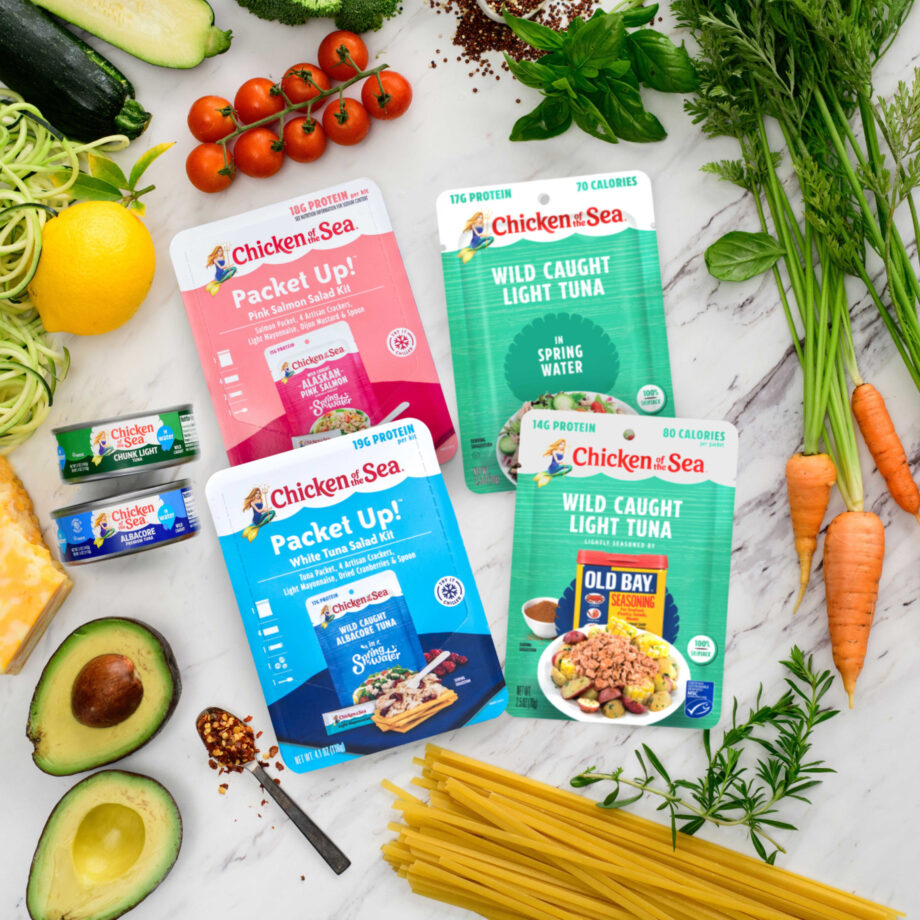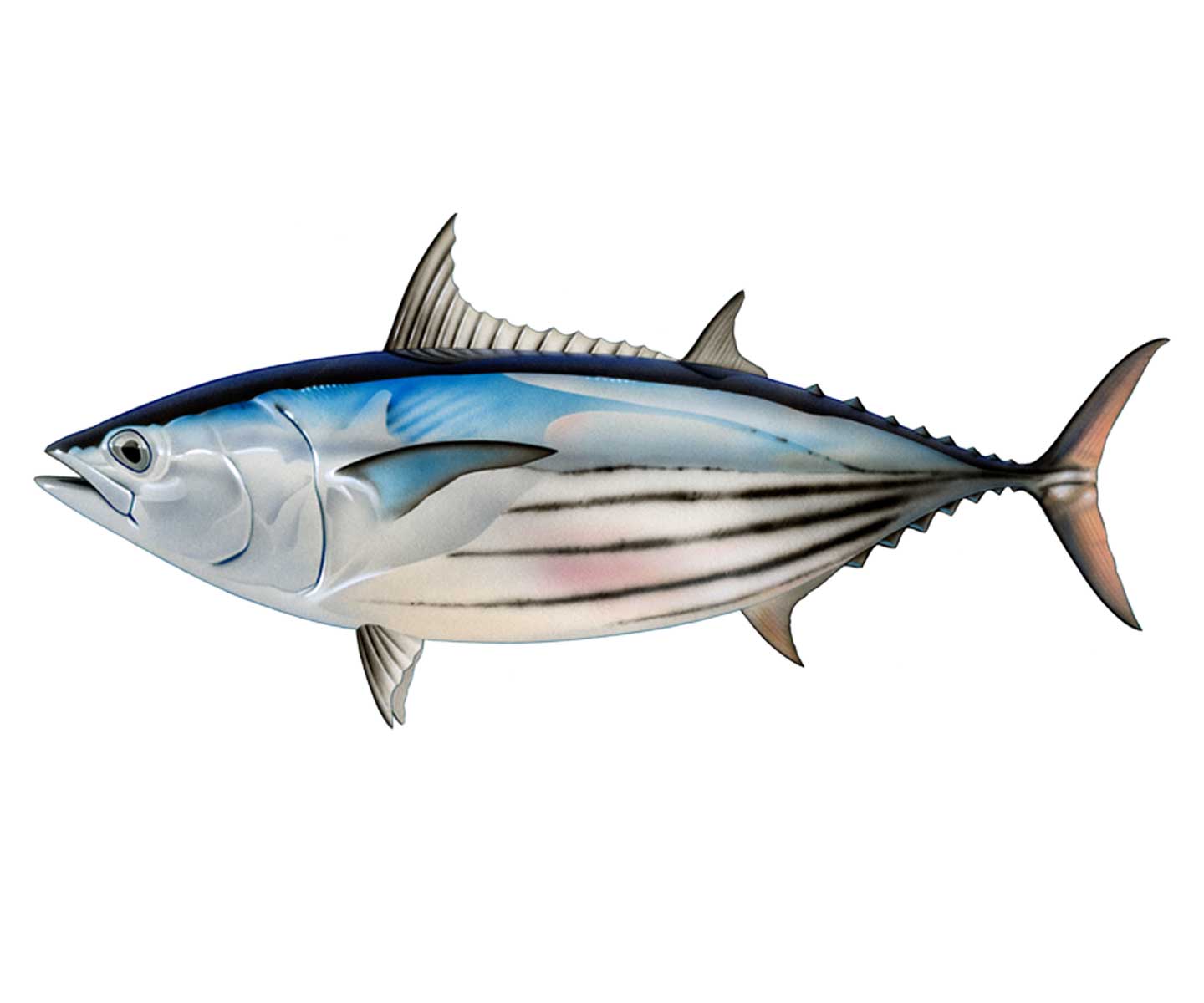Skipjack is a significant player in marine ecosystems and is a popular commercial catch and game fish. It’s a medium-sized fish found in tropical and subtropical waters worldwide. Skipjack tuna is tender meat, often used for canning as “Light Tuna”. It’s also known by various names, including katsuo, arctic bonito, aku, mushmouth, oceanic bonito, striped tuna, and victor fish.
Summary
Taste and Texture: stronger, fishier flavor and a softer texture than other species of tuna such as albacore.
Distinguishing Features: smaller size compared to other tuna species and have a bullet-shaped body with iridescent blue with black markings on the back.
Habitat: found in tropical and warm temperate waters worldwide, often in large schools near the surface.
Latin Name: Katsuwonus pelamis
Physical Characteristics
Skipjack have distinct physical characteristics that contribute to its adaptability in marine environments.
Streamlined Body
They boast a sleek, torpedo-shaped body that facilitates efficient swimming. Its streamlined form minimizes water resistance, allowing it to move swiftly through the ocean currents.
Scale Arrangement
Unlike many other fish, they lack scales across most of its body. However, they do have scales along the lateral line (a sensory organ running along the sides) and the corselet (an area near the pectoral fins). This unique scale distribution helps reduce drag during swimming.
Size and Weight
They can reach lengths of up to 1 meter (approximately 3 feet) and weigh between 8 to 10 kilograms (18 to 22 pounds). Despite its relatively modest size compared to other tuna species, they remain a vital component of marine ecosystems and commercial fisheries.
Ecology and Behavior
Skipjack tuna, within the Scombridae family alongside mackerels, are part of the Thunnini tribe, which encompasses all tunas, sharing a common ancestry and streamlined build. Thus, they are related to both tunas and mackerels within the broader Scombridae fish family. Skipjack tuna play both predator and prey roles, contributing to the dynamic balance of marine life.
Habitat and Shoaling Behavior
According to NOAA Fisheries, skipjack tuna is commonly found in tropical waters worldwide. It thrives in warm oceanic regions, including the Atlantic, Pacific, and Indian Oceans. These tuna are a highly migratory species and form large shoals, often consisting of thousands of individuals. Shoaling provides benefits such as increased protection from predators and improved foraging efficiency.
Diet
Skipjack tuna are voracious feeders. Their diet includes a variety of prey:
- Fish: They consume small fish such as anchovies, sardines, and flying fish.
- Crustaceans: Shrimp, krill, and other crustaceans are part of their diet.
- Cephalopods: Squid and octopus are important food sources.
- Mollusks: Skipjack tuna also feed on mollusks like cuttlefish and small clams.
Role as Predator
They are active and efficient predators in the pelagic (open-ocean) ecosystem:
- Forage Fish Consumers: They primarily feed on smaller schooling fish, such as sardines, anchovies, and other forage fish, playing a vital role in controlling these populations.
- Cephalopod and Crustacean Predators: They also consume squid, crustaceans, and other invertebrates, demonstrating a versatile diet that impacts various levels of the marine food web.
Role as Prey
They occupy a crucial position in the marine food web, serving as prey for several larger predators:
- Sharks: Various shark species, including blue sharks and mako sharks, target them.
- Large Pelagic Fishes: Other apex predators like marlins, billfish, swordfish, and yellowfin tuna hunt them as well.
Reproductive Biology
Skipjack’s reproductive adaptations allow it to maintain stable populations across their vast distribution range.
Batch Spawners
Skipjack tuna release their eggs and sperm in multiple reproductive events over a period of time. Unlike some other tuna species that spawn continuously, they follow a more structured reproductive pattern. In equatorial waters, they engage in year-round spawning. The warm and stable conditions near the equator provide an ideal environment for reproduction. But, as we move away from the equator, spawning becomes more seasonal. In temperate and subtropical regions, they tend to synchronize their reproductive efforts with specific seasons.
Age Determination Challenges
Determining the age of skipjack tuna is a complex task. Unlike species with clear growth rings (like tree rings), skipjack lack such visible markers. Scientists usually estimate their age based on size and average growth rates.
Commercial Importance
Skipjack tuna’s abundance and widespread distribution make it a vital player in the seafood industry. It serves as both a commercial fish and a popular game fish for recreational anglers and has a big impact on local economies where it is fished.
Global Landings and Major Fishing Countries
In 2018, global skipjack tuna landings reached approximately 3.2 million tonnes. Major fishing countries include:
- Indonesia: One of the largest producers.
- Philippines, Maldives, and Thailand: Significant contributors.
- Spain, Japan, and Taiwan: Also play a crucial role.
Fishing Methods
The primary method for catching skipjack tuna involves purse seine nets. These large nets encircle entire schools of tuna near the ocean surface. Purse seine fishing is efficient and allows for the capture of large quantities at once.
Forms of Sale
- Fresh: Sold in fish markets and supermarkets, especially in coastal regions.
- Frozen: Processed and frozen for export or storage.
- Canned: Canned skipjack tuna is widely consumed globally. Its stronger flavor works well in classic dishes such as tuna macaroni salad, tuna melt sandwiches, and tuna casseroles.
- Dried and Salted: Common in some cultures, especially in regions where fresh tuna is scarce.
- Smoked: Smoked skipjack tuna adds flavor to dishes and appetizers.
Sustainability and Conservation
Efforts to monitor skipjack populations, implement sustainable fishing practices, and adapt to climate-related changes are crucial for the long-term conservation of this valuable species.
Highly Reproductive
Each female can release millions of eggs during spawning events. This fecundity contributes to the species’ resilience and ability to maintain stable populations.
Sustainable Population
Currently, their populations are considered sustainable due to their rapid growth rates and abundant numbers. Responsible fishing practices, such as avoiding overfishing and minimizing bycatch, help maintain this balance. The use of fish aggregating devices can increase catch efficiency but raises concerns about bycatch and ecosystem impacts, requiring careful management.
Climate Change Effects
Climate change impacts ocean temperatures and currents, leading to shifts in skipjack tuna distribution. Some areas may become less suitable, while others become more favorable. Also, changes in water temperature affect their behavior and catchability. Warmer waters may alter their migration patterns and availability to fishing fleets.
Nutrition and Health Benefits
Incorporating skipjack tuna and other tuna species into your diet can provide a tasty and nutritious boost while potentially lowering the risk of various health conditions. Here are some of its potential health benefits:
Nutritional Value
- Vitamin D: A 5 oz can of skipjack tuna can contain up to 10% of the Daily Value for Vitamin D. Vitamin D is very important for bone health because it helps our bodies absorb calcium. It also plays a role in supporting immune health.
- Vitamin B12: Tuna is also an excellent source of vitamin B12, a crucial nutrient needed for DNA synthesis and the formation of new red blood cells. Adequate B12 intake helps prevent anemia and supports overall health.
- Omega-3 Fatty Acids: Tuna features omega-3s, which play a vital role in the inflammatory pathways in the body as well as support a healthy heart, eyes and brain.
Health Benefits
- Heart Health: The omega-3s in tuna help maintain a healthy balance between omega-6 and omega-3 fatty acids, reducing the risk of heart issues. By keeping arteries clear and supporting cardiovascular health, tuna consumption contributes to overall well-being. Plus, tuna is naturally low in sodium and or low-sodium options are available for canned tuna.
- Weight Management: Tuna is a lean protein, filling and satisfying without excess calories.
Frequently Asked Questions
What is another name for skipjack tuna?
Katsuwonus pelamis is widely recognized as skipjack tuna, but it’s also known by many other common names, including arctic bonito, atlantic bonito, banjo, bonito, lesser tunny, mushmouth, ocean bonito, oceanic skipjack, skipper, skippy, stripe bellied bonito, striped bellied tunny, striped bonito, striped tunny, victor fish, watermelon, and white bonito. This species boasts a remarkable variety of regional and colloquial names.
Which is healthier: skipjack or albacore tuna?
Both skipjack and albacore tuna provide valuable nutrients. Albacore tuna typically features higher levels of omega-3 fatty acids, which are beneficial for heart health. Skipjack, on the other hand, is a leaner protein source.
What is the difference between skipjack tuna and regular tuna?
Skipjack, like yellowfin, is a bit soft and has a rich, more intense taste than other tuna. It has darker meat, and is commonly canned as “Light Tuna.” In contrast, albacore tuna is larger, has white flesh, and is often called “White Tuna.”
Is skipjack tuna good to eat?
Yes. According to the FDA, due to its lower mercury content and higher selenium levels, it’s safe to enjoy up to three servings of skipjack tuna per week. Next time you go shopping, stock up on cans of “light tuna,” which typically consists mainly of skipjack (occasionally mixed with yellowfin).
Why is albacore tuna more expensive than skipjack?
Albacore, or “white” tuna, commands a higher price than “light” tuna, typically skipjack, due to its premium status derived from its milder flavor, firmer texture, and higher oil content. This preference, coupled with factors like stricter quotas and greater catch effort, results in albacore’s increased cost in the canned tuna market.
Sources:
- https://www.fda.gov/media/102331/download?attachment
- https://ods.od.nih.gov/factsheets/Omega3FattyAcids-HealthProfessional
- https://pmc.ncbi.nlm.nih.gov/articles/PMC7783742
- https://www.fisheries.noaa.gov/species/atlantic-skipjack-tuna
- https://animalia.bio/skipjack-tuna
- https://www.worldwildlife.org/species/skipjack-tuna
- https://www.fda.gov/food/consumers/questions-answers-fdaepa-advice-about-eating-fish-those-who-might-become-or-are-pregnant-or#II
- https://www.fda.gov/food/consumers/advice-about-eating-fish
- https://nutrivore.com/foods/skipjack-tuna-nutrients/

WHERE TO BUY
Overflowing with flavor, Chicken of the Sea packets and cans are ready for all your culinary adventures. Use our product locator to find the perfect salmon, tuna, crab or other seafood products from Chicken of the Sea.







